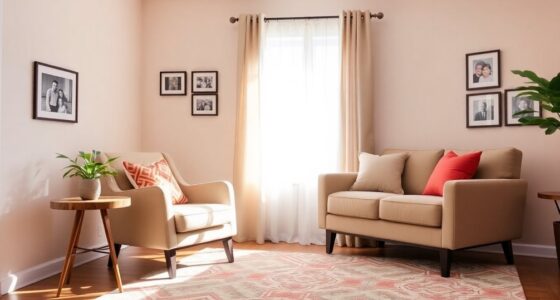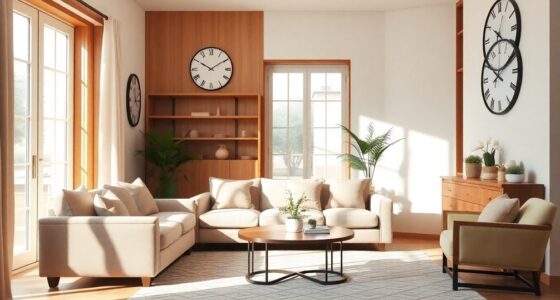To personalize senior living spaces, embrace personal touches with decor, like cherished family photos or hobby-related items. Create a cozy atmosphere using soft furnishings and nature-inspired colors. Integrate plants for a calming environment, and optimize your layout for comfort and accessibility. Multi-functional furniture can save space while enhancing functionality. Don't forget to incorporate safety features for peace of mind. With these ideas in mind, you'll find even more innovative tips to transform your space into a cherished home.
Key Takeaways
- Create a personalized gallery wall showcasing family photos and cherished memories to foster emotional connections in the living space.
- Design dedicated display areas for personal collections, using floating shelves or shadow boxes to reflect individual interests and encourage conversations.
- Incorporate soft furnishings like blankets and pillows along with calming colors to create a cozy and inviting atmosphere.
- Integrate natural elements like indoor gardens and large windows to promote well-being and enhance the aesthetic appeal of the space.
- Establish designated hobby zones with functional furniture to reflect passions and encourage engagement in creative activities.
Embrace Personal Touches With Decor
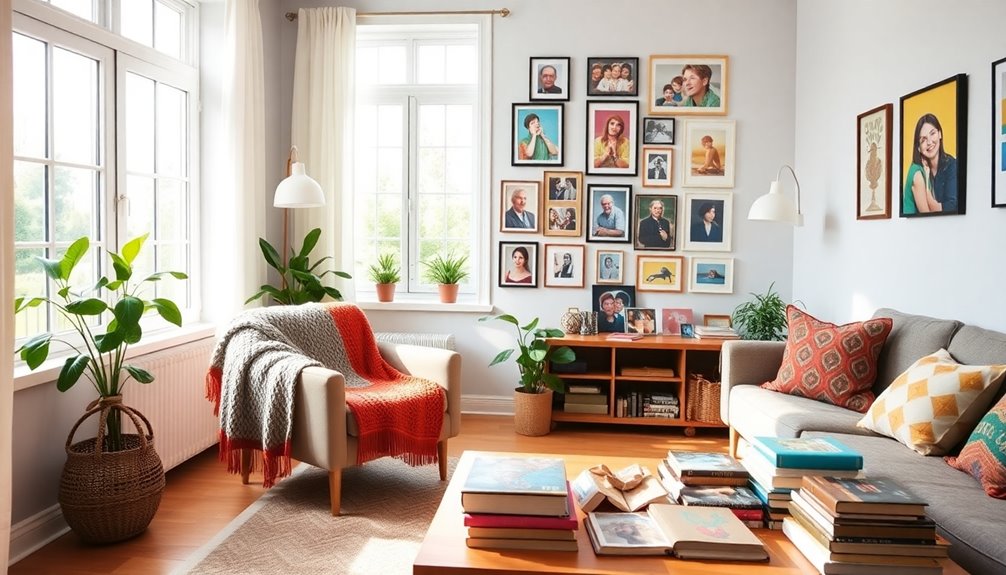
Embrace personalized living by displaying cherished items like family photos and heirlooms that tell your story. Create a personalized wall gallery to showcase your favorite memories, reinforcing your identity and connection with loved ones.
Reflect your hobbies and interests through decor—books, art, or collections encourage engagement and spark conversations. Additionally, navigating small mistakes in your decor choices can lead to more fulfilling and intentional designs. Choose calming colors and soft textures to enhance your emotional well-being; warm tones and cozy fabrics provide comfort. Incorporating gentle methods in your decor choices can create a nurturing environment that prioritizes emotional needs.
Moreover, consider incorporating sustainable materials that not only elevate your decor but also promote a healthier living environment. Finally, add plants and natural elements to improve air quality and create a serene atmosphere, connecting you to nature.
These thoughtful touches transform your space into a vibrant, inviting home.
Create a Cozy and Inviting Atmosphere
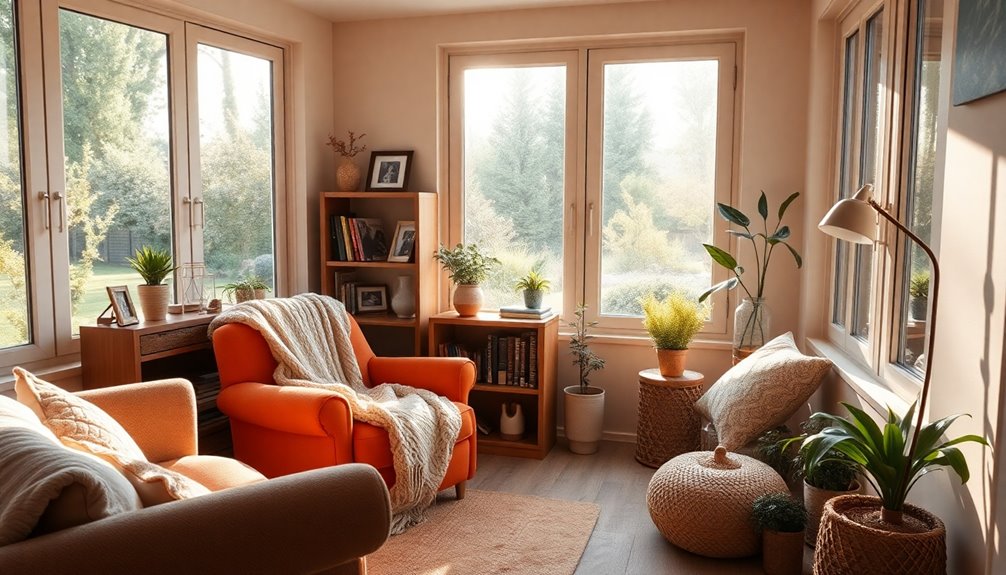
Creating a cozy and inviting atmosphere is key to making senior living spaces feel like true homes. Start by incorporating soft furnishings like blankets, pillows, and rugs to enhance warmth and comfort. Use a calming color palette featuring nature-inspired hues such as blues and greens to foster relaxation and reduce stress. Guarantee ample natural light flows through the space, utilizing soft, warm lighting for a welcoming ambiance. Additionally, consider using layered lighting to create a more versatile and inviting environment.
Consider adding a gallery wall with framed family photos that reflect personal style, creating a visual reminder of cherished memories. These thoughtful touches not only promote emotional well-being but also make the environment feel more personal and connected, encouraging residents to truly enjoy their surroundings. Furthermore, integrating universal design principles in your space can ensure it meets the changing needs of seniors over time. Additionally, incorporating antiques that serve a purpose can enhance the character of the space while providing functional decor options.
Integrate Nature for a Calming Environment
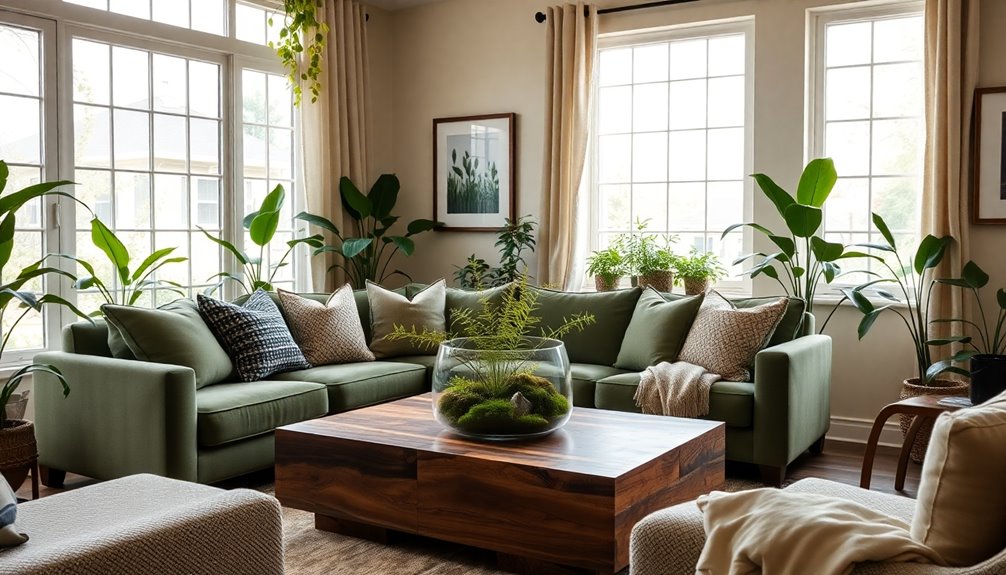
Bringing nature indoors can transform your living space into a soothing sanctuary.
Consider adding indoor gardens and greenery, which not only beautify but also promote well-being.
Pair that with large windows to flood your home with natural light, and use natural materials for a calming, refreshed atmosphere.
Indoor Gardens and Greenery
When you integrate indoor gardens and greenery into senior living spaces, you not only enhance aesthetics but also create a calming environment that greatly benefits residents' emotional well-being.
Research shows that exposure to plants can reduce stress and anxiety, making indoor gardens a crucial addition. Choose low-maintenance plants like succulents and snake plants, which require minimal care while offering the soothing presence of nature.
Incorporating natural materials in your design can further promote tranquility. Additionally, these gardens encourage residents to engage in gardening activities, fostering social interactions and enhancing their sense of community. Furthermore, creating cozy spaces can help facilitate relaxation and socialization among residents.
Large Windows for Light
Indoor gardens and greenery set the stage for enhancing senior living spaces, but large windows take that connection to nature a step further.
By incorporating large windows, you not only invite natural light but also promote the well-being of seniors.
Here are three benefits of creating a space with large windows:
- Enhanced Mood: Ample natural light can uplift spirits and reduce feelings of depression.
- Improved Health: Exposure to sunlight supports better sleep patterns and increases vitamin D levels, which is essential for overall health. Additionally, proper nutrition is crucial for maintaining optimal cognitive function, further enhancing the positive effects of natural light.
- Stress Reduction: Views of nature through large windows can lower stress levels and improve mental clarity.
Strategically positioning large windows maximizes sunlight, fostering tranquility and reducing the need for artificial lighting, ultimately creating a serene living environment for seniors. Additionally, hydration is crucial for maintaining optimal brain function, which can be further supported by the natural light that large windows provide.
Natural Materials and Textures
Natural materials and textures play an essential role in creating a calming environment for seniors, as they foster a sense of warmth and comfort. By integrating materials like wood, stone, and bamboo, you enhance the connection to nature, which promotes overall well-being. Incorporating earthy greens and blues can further reinforce this connection and create a more inviting atmosphere.
Textures from natural fibers such as cotton, linen, and wool add coziness and comfort, essential for emotional health. Incorporating indoor plants not only infuses vibrancy but also improves air quality and reduces stress, creating a serene space. Additionally, the use of traditional patterns can enhance visual interest and cultural connection in the design.
Utilizing biophilic design principles, which highlight natural elements and views of nature, helps reduce anxiety and promote tranquility. Large windows let in natural light, further enhancing the calming ambiance and helping regulate mood and circadian rhythms. The use of natural materials in design reinforces the importance of sustainability and eco-friendly practices.
Personalize With Family Photos and Memories
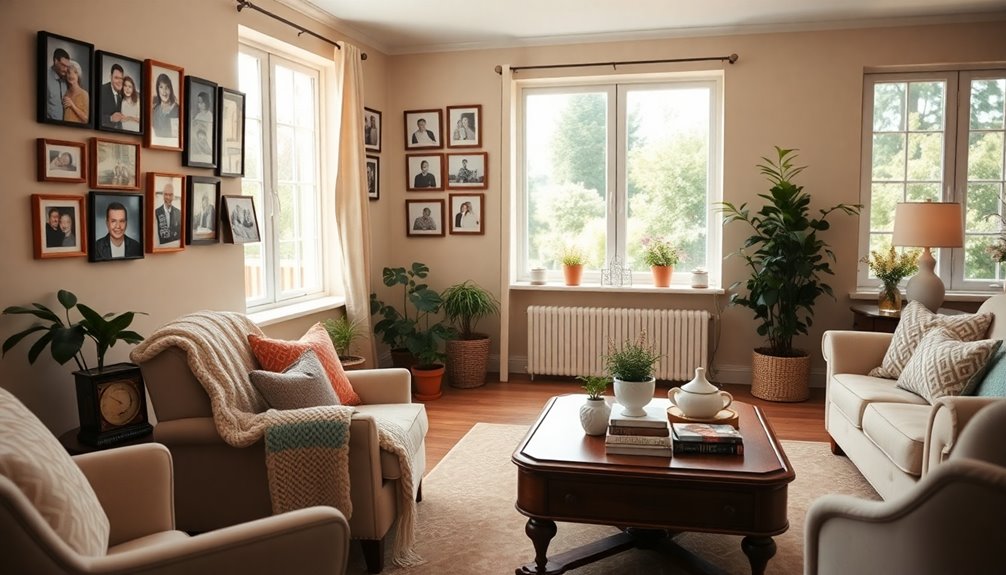
Personalizing the space with family photos and cherished memories is a great start. Not only do they evoke positive feelings, but they also enhance emotional well-being and reduce loneliness. Additionally, open communication about feelings can further support emotional stability during transitions.
Here are three ideas to reflect upon:
- Create a gallery wall: Display a variety of family photos from different life stages to spark conversation and reminiscence.
- Strategically place framed photos: Position these personal decor items around the living area to remind you of loved ones and joyful times.
- Incorporate small mementos: Add cherished items that reflect your personality and interests, making your space uniquely yours.
These touches create a comforting atmosphere and help ease the shift into senior living. Additionally, incorporating mood boards can help visualize how these personal elements will blend with the overall design of the space.
Showcase Hobbies and Interests
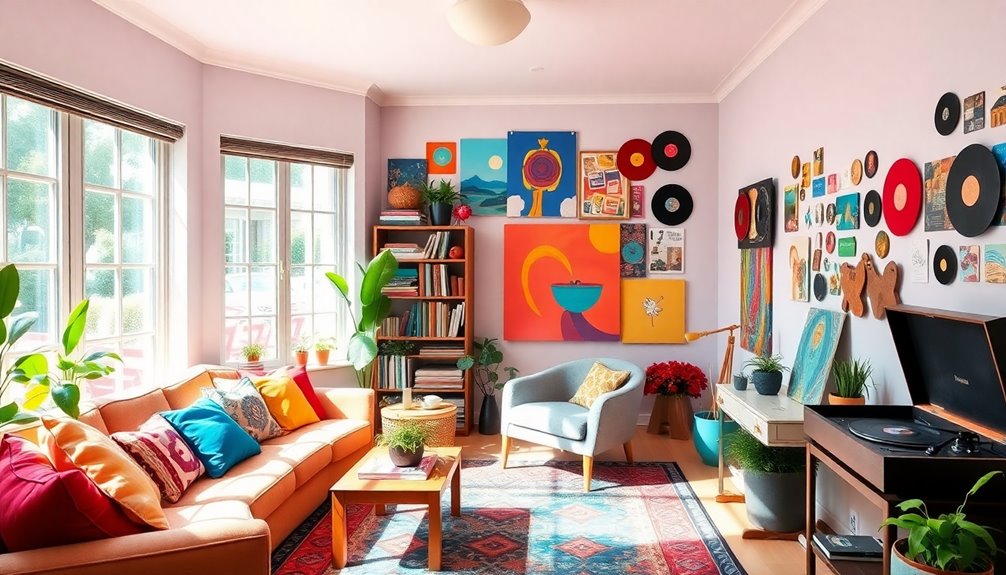
Showcasing your hobbies in your living space can truly make it feel like home.
By creating designated zones for activities you love, like a cozy reading nook or a space for your collection, you encourage engagement and enjoyment.
Adding interactive elements not only sparks creativity but also invites others to share in your passions. Incorporating brightly colored flowers can enhance the ambiance and create a vibrant atmosphere that reflects your personality.
Display Personal Collections Creatively
Creating dedicated display areas for personal collections can transform a senior living space into a vibrant reflection of individual hobbies and interests.
By thoughtfully arranging decorative items, you can create a space that not only showcases your passions but also meets your unique needs.
Consider these ideas:
- Wall-Mounted Displays: Use floating shelves to highlight books, figurines, or art, making them accessible and visually appealing.
- Shadow Boxes: Create custom shadow boxes to showcase smaller collections like keepsakes or memorabilia, adding depth to your decor.
- Rotating Features: Periodically change featured items to keep your display fresh and exciting, allowing you to share different aspects of your interests with visitors.
These personalized touches foster pride and spark engaging conversations.
Designate Hobby Zones
While it's essential to design a comfortable living space, dedicating specific areas for hobbies can truly enrich your daily life. By designating hobby zones, you create a personalized space that reflects your passions, whether it's crafting, gardening, or reading. Incorporating functional furniture like a crafting table or reading nook maximizes space efficiency and enhances engagement.
Here's a quick look at how to personalize your hobby areas effectively:
| Hobby | Essential Features |
|---|---|
| Crafting | Crafting table, organized supplies |
| Gardening | Plant pots, natural light |
| Reading | Comfortable seating, adequate lighting |
| Painting | Easel setup, vibrant decor |
| Puzzles | Puzzle table, good lighting |
These thoughtful touches encourage participation and promote overall well-being.
Incorporate Interactive Elements
Personalizing senior living spaces goes beyond just designating hobby zones; it's about incorporating interactive elements that truly celebrate individual interests.
By creating engaging environments, you enhance the sense of community and creativity. Here are three ideas to evaluate:
- Interactive Spaces: Use wall-mounted pegboards or corkboards to allow residents to easily showcase their artwork or projects, keeping the environment dynamic.
- Display Features: Integrate shadow boxes or glass cabinets to highlight cherished collections, inviting residents to share their stories with visitors.
- Multi-Functional Furniture: Opt for tables with built-in storage for art supplies or games, making it easier for residents to engage in personal hobbies while promoting social interaction in communal hobby areas.
Select a Thoughtful Color Palette
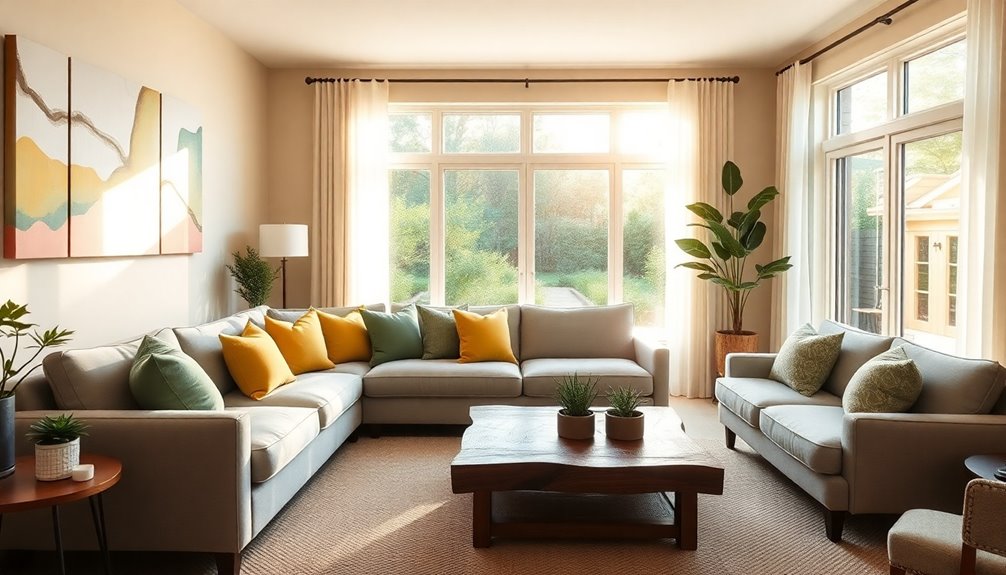
Selecting a thoughtful color palette can greatly impact the emotional well-being of seniors in living spaces. Calming blues and greens can promote relaxation, while warmer hues like oranges and yellows evoke positive emotions, particularly in Memory Care settings.
Incorporating nature-inspired colors, such as browns and golds, enhances comfort and creates a homelike feel that resonates with familiarity. Don't forget to use the 2022 color of the year, Orchid flower, as a vibrant accent to spark joy and hope.
Aim for a balanced mix of bold and neutral tones to create harmony, ensuring spaces feel inviting. Finally, be mindful of community regulations to reflect residents' individuality and personal preferences while staying within guidelines.
Optimize Layout for Comfort and Accessibility
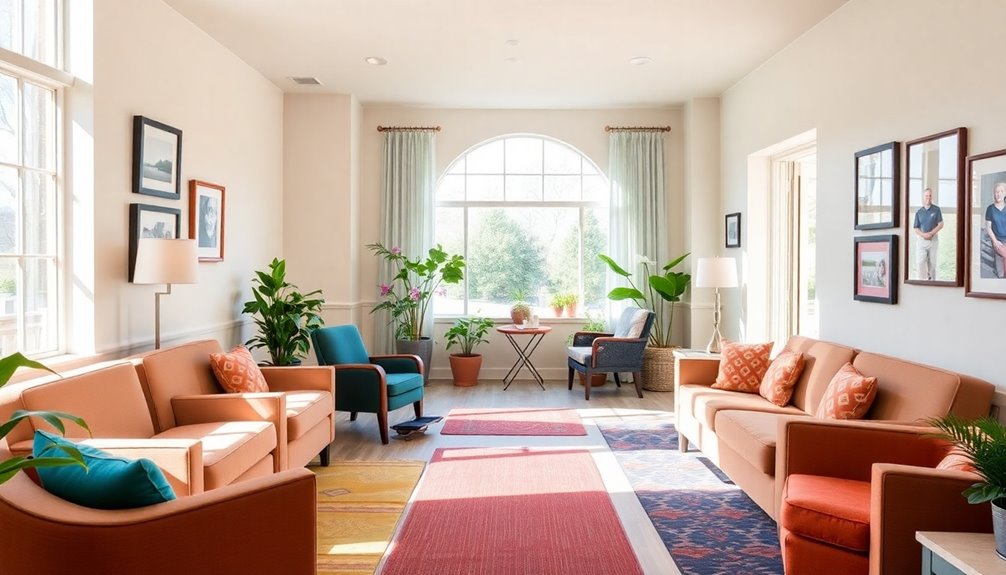
To create a comfortable and accessible living space, focus on prioritizing clear pathways that allow easy movement.
Incorporating multi-functional furniture solutions can help maximize your space while providing essential utility.
Additionally, make certain that storage options are easily reachable to enhance both safety and convenience for residents.
Prioritize Clear Pathways
When designing senior living spaces, prioritizing clear pathways is essential for guaranteeing comfort and accessibility. A well-organized layout can noticeably enhance mobility for residents using mobility aids.
Here are three key strategies to implement:
- Width: Verify pathways are at least 36 inches wide to allow easy navigation with walkers or wheelchairs.
- Furniture Arrangement: Arrange furniture to create an unobstructed flow, avoiding clutter and potential trip hazards. Consider placing a comfortable chair in strategic locations for rest.
- Safety Features: Use non-slip area rugs and secure loose cords to prevent falls, especially in high-traffic areas.
Regularly assess the layout to adapt to residents' evolving needs, guaranteeing that the space remains accessible and inviting.
Multi-Functional Furniture Solutions
Multi-functional furniture solutions can transform senior living spaces into comfortable and accessible environments. By incorporating items like storage ottomans and convertible sofas, you maximize space efficiency while ensuring comfort.
These multi-functional furniture pieces come with built-in storage solutions, helping reduce clutter and making essential items easily accessible. Ergonomic designs in seating, such as power recliners, provide comfort and accommodate mobility needs, enhancing usability.
Additionally, adjustable height tables and desks support various activities, from dining to hobbies, allowing you to engage comfortably and maintain independence.
Finally, selecting lightweight furniture encourages flexibility, making it easier for you to personalize living spaces according to your preferences. Embrace these innovative solutions to create a more functional and inviting home.
Accessible Storage Options
While creating a comfortable living space, accessible storage options are essential for promoting independence and ease of use.
You can implement practical storage solutions that cater to diverse needs, ensuring personal items are always within reach. Consider these ideas:
- Multi-functional furniture: Use ottomans or coffee tables with built-in storage to maximize space.
- Vertical storage: Install tall bookshelves or wall-mounted cabinets to minimize clutter while keeping frequently used items accessible.
- Organized closets: Design closets with adjustable shelving and pull-out drawers, ensuring easy access for everyone.
Additionally, use labeled bins or baskets to help identify items quickly.
Incorporate Multi-Functional Furniture
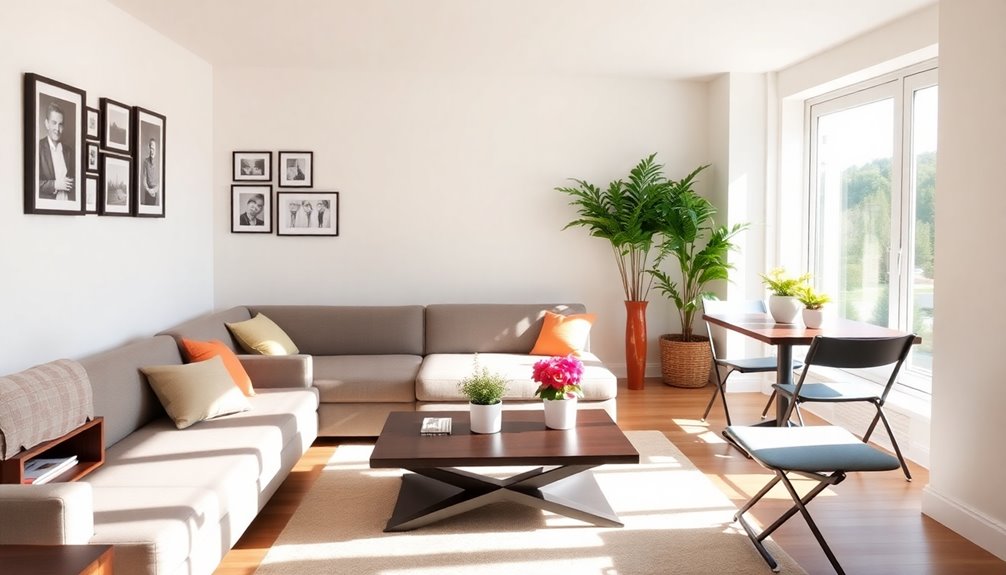
In smaller senior living spaces, incorporating multi-functional furniture can make a world of difference. By choosing pieces like sofa beds or storage ottomans, you maximize space efficiency, allowing for relaxation and storage in one solution.
Look for furniture with built-in storage, such as coffee tables with compartments or beds with drawers, which help reduce clutter and keep essentials within easy reach. Ergonomic designs in these items provide comfort and assist mobility, making shifts between activities smoother.
Consider adjustable height tables or desks to accommodate various activities, from dining to crafting, promoting independence and versatility in your living spaces. Plus, selecting visually appealing multi-functional pieces, like stylish benches that double as storage, keeps your environment practical yet aesthetically pleasing.
Enhance Safety With Thoughtful Design Elements
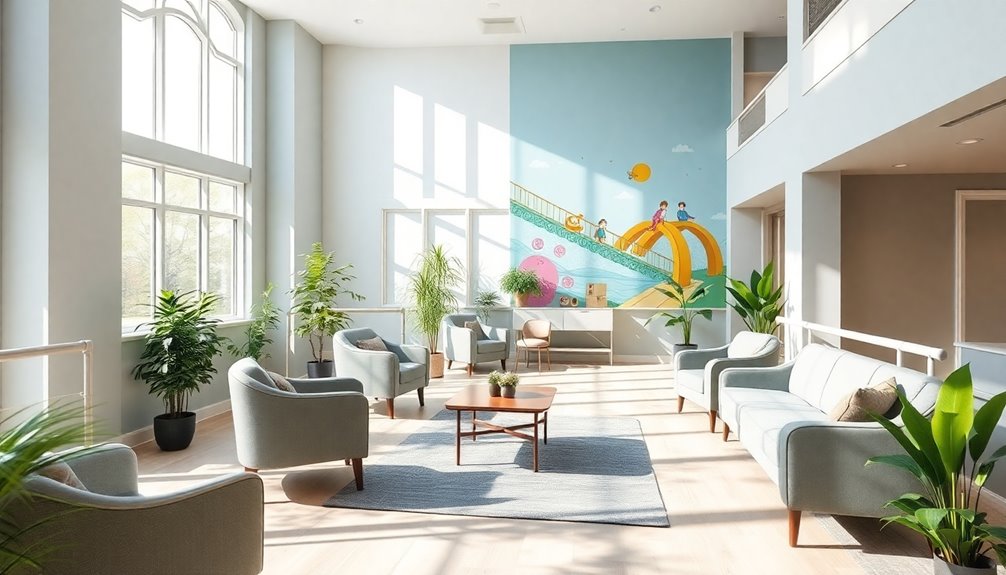
Choosing the right furniture is just one step in creating a safe and comfortable living environment for seniors.
To truly enhance safety, consider the following design elements:
- Non-slip flooring: Implementing this flooring reduces the risk of falls, a common injury among seniors.
- Grab bars: Installing these in bathrooms and hallways provides essential support for maneuvering and standing, guaranteeing stability.
- Adequate lighting: Guarantee well-lit areas to help seniors see better, especially in high-traffic zones, minimizing accident risks.
Additionally, opt for lever-style door handles, as they're easier for those with limited hand strength.
Utilize Technology for Convenience and Connection
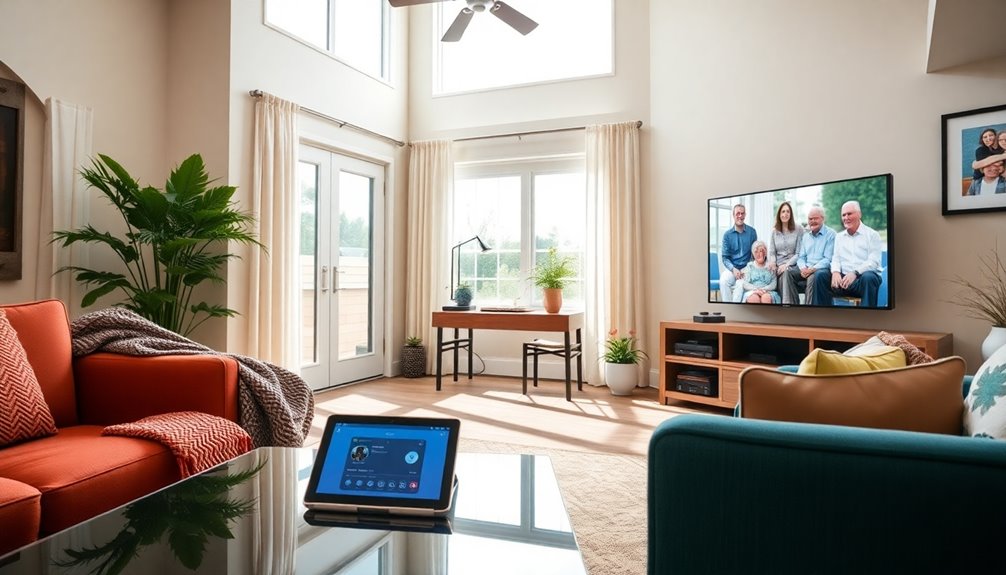
As technology continues to evolve, integrating smart solutions into senior living spaces can greatly enhance convenience and connection.
By implementing voice-activated assistants, you can control smart devices, access information, and communicate easily, promoting independence.
Smart locks and keyless entry systems improve security while eliminating the hassle of managing physical keys.
Telehealth options allow you to connect with healthcare providers from home, ensuring timely medical attention when needed.
Additionally, fall detection systems can alert caregivers in emergencies, enhancing safety.
With user-friendly technology interfaces and training sessions, you'll feel empowered to use these devices effectively, fostering a sense of control and keeping you connected with family and friends.
Embracing technology truly transforms the senior living experience.
Frequently Asked Questions
How Can I Incorporate Cultural Elements Into Senior Living Design?
To incorporate cultural elements into senior living design, you can start by collecting meaningful artifacts, textiles, and artwork that reflect residents' backgrounds.
Use colors and patterns that resonate with their heritage to create a warm atmosphere.
Consider hosting cultural events or workshops, allowing residents to share their traditions.
You could also design communal spaces that celebrate diverse cuisines, encouraging social interaction and fostering a sense of community among residents from different backgrounds.
What Types of Flooring Are Safest for Seniors?
Imagine walking on a cloud, soft and supportive beneath your feet.
For seniors, the safest flooring options include carpets with low pile, which cushion falls and reduce slipping. Vinyl and laminate also offer smooth surfaces that resist moisture, while textured tiles provide grip.
Avoid slick surfaces like polished hardwood, as they can be treacherous.
How Can I Personalize a Shared Living Space?
Personalizing a shared living space can be a fun and rewarding process. Start by incorporating items that reflect your personality, like artwork or photographs.
You could also choose a color scheme that resonates with you. Consider using multifunctional furniture, which maximizes space while keeping it cozy.
Discuss preferences with your housemates to guarantee everyone feels included.
Finally, small touches like plants or decorative pillows can make the space feel more inviting and uniquely yours.
What Are the Best Lighting Options for Seniors?
When choosing lighting options for seniors, you'll want to prioritize brightness and ease of use.
Opt for warm LED lights to create a cozy atmosphere, and consider dimmable fixtures for flexibility.
Install motion-sensor lights in hallways and bathrooms for safety.
Use table lamps with easy-to-reach switches, and guarantee there's plenty of natural light during the day.
Task lighting is essential for reading or hobbies, so don't forget those key areas!
How Do I Choose the Right Size Furniture for a Small Room?
When you're choosing the right size furniture for a small room, start by measuring your space.
Consider the room's layout and how you want to use it.
Opt for multi-functional pieces, like a sofa bed or an ottoman with storage.
Keep the scale proportional; avoid bulky items that overwhelm the space.
Light colors can create an open feel, making the room appear larger.
Finally, leave enough walkways for easy movement throughout the area.
Conclusion
So, while you might think senior living spaces have to feel bland and institutional, it's time to challenge that notion. By embracing personal touches and innovative design ideas, you can create a vibrant, comfortable home that reflects individuality. After all, why settle for cookie-cutter when you can have a unique sanctuary? Let your creativity shine and transform these spaces into warm, inviting environments that truly feel like home, proving that age is just a number, not a limitation.


